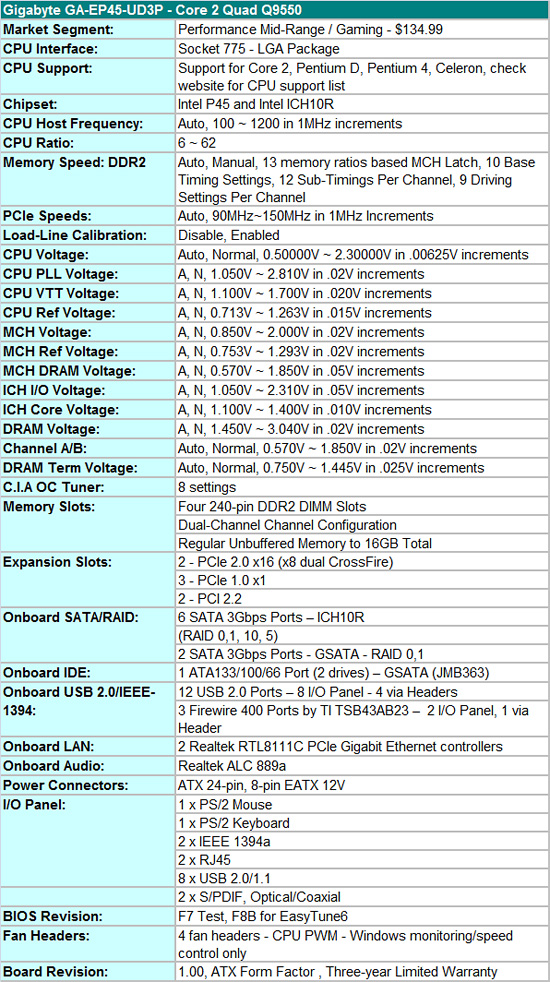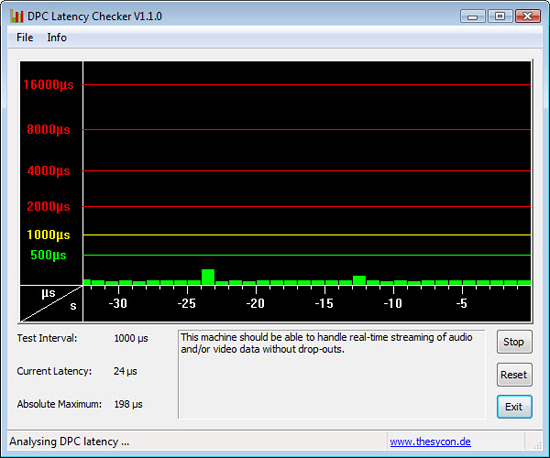Gigabyte GA-EP45-UD3P - P45 at its Finest
by Gary Key on February 3, 2009 12:15 AM EST- Posted in
- Motherboards
Gigabyte GA-EP45-UD3P
Feature Set

Gigabyte includes the standard array of components like the Realtek ALC889A HD audio codec with Dolby Home Theater support, dual Realtek RTL8111C Gigabit LAN chips with teaming support, T.I. TSB43AB23 IEEE 1394a chipset, GSATA2 (JMB363) chipset, Intel ICH10R, and full support for the Core 2 processor series, Pentium D, Pentium 4, and Celeron processors. Be sure to double check Gigabyte’s CPU support list to ensure full support for your processor.
Gigabyte also includes a rather generous accessories bundle for a motherboard in this price point. You get the standard rear I/O panel cover along with 1 x floppy cable, 1 x IDE cable, 4 x SATA cables, 1 x dual eSATA PCI expansion bracket with an eSATA cable and external molex connection, well-written and informative manual, software CD, and an illustrative installation guide.
BIOS
Gigabyte also includes one of the most extensive BIOS designs in a midrange motherboard that we have seen recently. The BIOS is setup for the serious overclocker and includes all the basic settings: CPU multiplier, PCI-E bus, Northbridge latch (FSB Strap), FSB frequency, memory multipliers, and nearly every voltage setting you will need. Gigabyte finally includes Load Load-Line Calibration (LLC) and ICH Core (Southbridge) voltage settings. LLC will help to eliminate line droop on the VCore line. We still recommend having LLC disabled in most situations, but if you have to reach a certain overclock for benchmarking, then you should probably enable it. Generally, we do not need ICH voltages in our experience but it is nice to have the feature.
Two strengths of the BIOS are the abundant voltage settings and extensive memory timing options. Gigabyte allows you to tweak tRD phase adjustments, DIMM clock skews, and memory driving strengths. For those who do not wish to tinker that much, Gigabyte provides Drive Strength Profiles (667/800/1066/OC-1200/OC-1333), which can take the guess work out of overclocking your memory. We found that these settings will get you about 98% of the way there when trying to get that last few ns in latency removed or ensuring memory stability when overclocking.
One last feature we would like to mention is the updated Q-Flash utility that is accessed via the F8 key. Q-Flash can read files directly from a USB flash drive making BIOS updating a simple and safe procedure. We tried this feature 100 times as part of our testing routine and it never failed.
We did have a couple of slight disappointments with the BIOS. In the voltage setting options, Gigabyte does not provide the base voltages that the board defaults to at startup. Our other complaint has to do with the PC Health section, as there is a lack of voltage and temperature readouts. Other than that, we were very impressed with the BIOS.
Tech
One of the most important features that Gigabyte implemented in the GA-EP45-UD3P motherboard is the Ultra Durable 3 technology. As a follow up to UD2, Gigabyte improved their component selections and electrical layout to optimize the board. Ultra Durable 3 features lower ESR solid capacitors, lower RDS(on) MOSFETs, and ferrite core chokes. Gigabyte now rates the longevity of the solid capacitors at 50,000 hours or approximately 6 years of continuous use.
The second major improvement cited by Gigabyte in their Ultra Durable 3 design is the introduction of a 2-ounce copper PCB for both the Power and Ground layers compared to the typical 1-ounce layers found in most consumer boards. Gigabyte claims this new motherboard design offers substantially lower system temperatures, superior energy efficiency, and improved overclocking. We are working on verifying the temperature and energy efficiency claims; both are certainly improved over the previous design but we need to understand if that comes from the BIOS, new heatsink design, and improved DES or if there really is something to UD3.
We have asked Gigabyte for their internal test results when it comes to board thermals and longevity of the capacitors. We would agree that overclocking is improved compared to the previous generation board. Whether that is BIOS or board design is up for debate, but considering our overclocking experiences, we think it is mostly board design. We will provide a follow-up shortly on DES and UD3; in the meantime, our simple comment is that this board is loaded and well built.
DPC Latency

We get a lot of requests for DPC latency results on each board we test. The latency variations between manufacturers utilizing the same chipset varies more than one might imagine. In the past, Gigabyte has had problems in this area. We are happy to report that it appears those problems are thing of the past, at least on this board. Our test used the E8600 at stock settings with 8GB of memory installed with timings set to 5-5-5-15 at DDR2-1066.










73 Comments
View All Comments
GhettoFly - Tuesday, February 3, 2009 - link
I'm guessing the 1250 kit you guys managed to clock at 1300 was Corsair's TWIN2X2048-10000C5DF. I have a set of those, but haven't tested with my UD3P yet; however I got my Geil DDR2-1160 C4 kit up to DDR2-1333 C5 on this board with only 2.48V using the 1333 OC profile: http://i4memory.com/f90/gigabyte-ep45-ud3p-memory-...">http://i4memory.com/f90/gigabyte-ep45-ud3p-memory-...This board is too much fun!
Gary Key - Wednesday, February 4, 2009 - link
Yes, it is the Corsair kit and it was an early review sample to boot. Corsair sent us a new SPD and I managed to hit 1333 this morning at 2.50V on it, so I can report that 1333 is stable on this board now after a few runs of Crysis and PCMark Vantage. :)GhettoFly - Wednesday, February 11, 2009 - link
It just seems a bit odd advertising DDR2-1366+ OC capabilities when the ICs needed for such clocks (D9GMH/GKX) are EOL :px86 64 - Sunday, February 15, 2009 - link
I'm still seeing some around and very cheap compared to what they used to be. You can pick up two 2x1GB (4GB) kits of PC2-10400 or PC2-9600 for under $275-$300 US.I think there are third party manufacturers who are still making the D9GMH\GKX, etc, because companies like Cellshock (now recently defunct) and Team Group (active) are still selling both of the most popular flavors of D9. Team is very big in Asia so it's not like they are some small niche company like Cellshock moving a small quantity of old stock. All of Team Group's Xtreem memory (not the "Dark" branding) is either GMH or GKX. How else to explain the constant flow of Micron D9 IC's to certain companies? Could there be that much stock still left over in Asia where they are selling them this long after they were discontinued?? I would be surprised.
GhettoFly - Sunday, February 15, 2009 - link
It has to be old stock of the ICs at least; when you look at the codes on the ICs themselves (not the D9Gxx code, but like 7KD22) I'm pretty sure the first number indicates the year of manufacture, 7 being 2007, 6 being 2006, etc. I haven't see any Micron RevD chips that have those codes staring with 8 even on sticks with a 2008 production date, for example my Geil 1160 C4 and Team Xtreem 9600 kits, the ICs on both have that code starting with a 7.Mr Roboto - Wednesday, February 18, 2009 - link
I don't know what the number is on the IC's themselves but you can check the manufacture date of your memory using a monitoring program like Everest.I have a set of Team's and using Everest they say the 14th week of 2008 as the date or manufacture.
Whether or not the IC's were made then or the modules themselves is debatable.
x86 64 - Sunday, February 15, 2009 - link
I think you might be right. I just pulled the spreaders off my Team 1200Mhz and sure enough it starts with a 7. I hope they don't run out anytime soon because it's so much fun to push this stuff :)It's weird, this has to be the first time in a long time that I'm happy with "last generation" hardware. I just don't see the benefit of i7 and DDR3 right now. I'm enjoying the rock solid P45, excellent inexpensive dual and quad Penryn's and dirt cheap high performance memory. I'd rather buy double the current hardware then spend the same amount for an entry level i7 system and get a 20% increase in performance. I'm sure the i7 will make a great server or HPC but I'm not impressed to much with the desktop parts. We need some multithreaded applications first. Software is seriously lagging.
I'll wait for the die shrink and in the mean time stick with my DDR2 and D9GKX\GMH :)
x86 64 - Sunday, February 15, 2009 - link
Also here's a picture of a TG kit from a review at XBit Labs from the summer of 2007 and it's marked with a 6 which would be in line with the markings on the recent chips, just one year back.http://www.xbitlabs.com/images/memory/team-xtreem/...">http://www.xbitlabs.com/images/memory/team-xtreem/...
GhettoFly - Wednesday, February 18, 2009 - link
Looks like I have to eat my words about no D9 being manufactured in 2008, these are powering the G.Skill 2GBHK sticks I got in today.http://www.xtremesystems.org/forums/showpost.php?p...">http://www.xtremesystems.org/forums/showpost.php?p...
Glenn - Tuesday, February 3, 2009 - link
Great article Gary! I have built approximately 10 systems so far with this board or it's single PCIe X16 twin UD3R, and the "C" version with the DDR3/DDR2 slots. My experiences with each are just as pleasing as you have reported. My own system is the C version with a Q9550 slightly overclocked to 3.4GHz. I am excited to see the followup on the Ultra Durable 3 technology.I am equally or even more excited that you are testing the support of Gigabyte and other manufacturers. I have built over 100 systems using gigabyte P35/G35 and now P45/G45 boards in the past year and a half and I honestly nearly quit using them over some issues with the G45 board when it was first released. It wasn't even close to stable but subsequent bios'es corrected all my complaints. I could get no response from Gigabyte during that time and was pretty pist off! Interestingly enough, I just about switched all my builds to Asus, but I was reminded of past problems with them on my first P45Q build when I went to download the newest drivers! Why does a multibillion dollar company like Asus insist on having a dog-assed slow website that is so painful to negotiate? At times during the day, one can't even get a page to open without timing out! And it's been that way for years! Gigabyte! You owe Asus a "save" on that one! Kudos to Anands crew for taking up these frustrations with the mfgs! Great article!